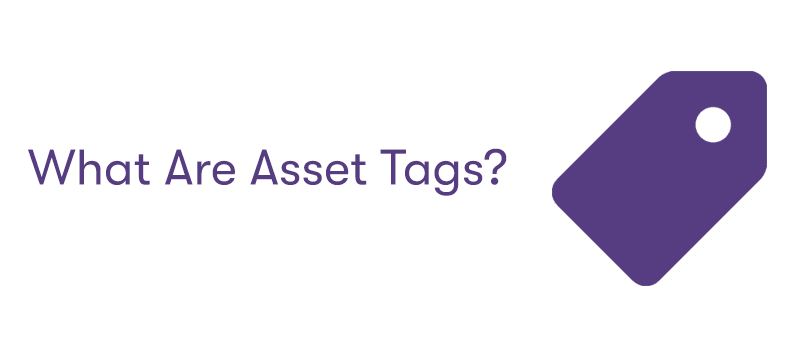What Are Asset Tags?
Welcome to our in-depth blog on asset tags, a pivotal element in contemporary asset management that often goes unnoticed yet plays a fundamental role in the efficiency and success of businesses. Understanding asset tags becomes crucial in a world where the effective management of physical and digital assets is paramount.
These small but mighty tools are more than identifiers; they are the linchpins in tracking, managing, and optimising a company's valuable resources. From tiny barcodes to sophisticated RFID chips, asset tags embody a synergy of technology and strategy.
Join us as we delve into what asset tags are, their types, applications, and their undeniable importance in business operations.
What Are Asset Tags?
Asset tags are labels attached to physical assets to help track and manage them. These tags usually contain information such as a unique identification number, barcodes or QR codes, and sometimes additional details like the name of the asset, its purchase date, and other relevant data.
Here are some key points about asset tags:
| Key Points on Asset Tags | Description |
| Identification | Each tag has a unique identifier, essential for tracking individual assets. |
| Types of Tags | Asset tags can be made of various materials like plastic, metal, or tamper-evident labels. They often use barcodes or QR codes that can be scanned for easy identification and tracking. |
| Usage in Inventory Management | They are widely used in inventory management systems across various industries. By scanning the asset tag, companies can quickly access information about the asset, such as its location, status, and maintenance history. |
| Durability | Asset tags are designed to be durable and withstand the environment where the asset is used. For example, tags used in outdoor settings or harsh industrial environments are often made of more robust materials. |
| Integration with Software Systems | Asset tags are often used in conjunction with asset management software. This software can track the asset's movement, maintenance schedules, and other essential details. |
| Applications | They are used in various applications, from tracking IT equipment in offices to managing machinery in manufacturing plants and even tracking furniture and fixtures in corporate environments. |
Asset tags are crucial in efficient asset management, helping organisations keep track of their physical resources, reducing losses, and streamlining inventory processes.
What Are the Benefits of Asset Tagging?
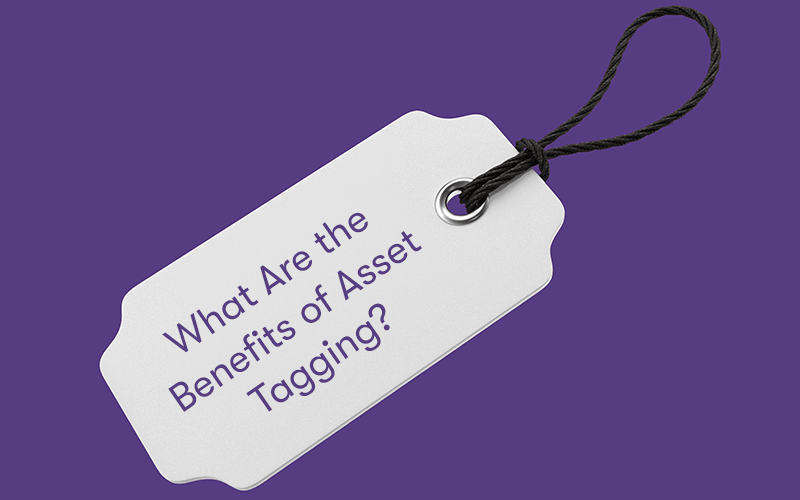
Asset tagging offers several significant benefits for organisations, enhancing the efficiency and accuracy of asset management. Here are some of the key benefits:
Improved Asset Tracking and Management
Asset tags make it easier to keep track of the location, status, and movement of assets. This is particularly beneficial for companies with a large numbers of assets or those spread across multiple locations.
Enhanced Inventory Control
With asset tags, businesses can more accurately count and manage their inventory. This reduces the likelihood of asset misplacement, loss, or theft, thereby minimising unnecessary expenses for replacing lost or unaccounted items.
Efficient Maintenance and Upkeep
Asset tags allow for easier scheduling and tracking of maintenance and repairs. By knowing the history and status of an asset, companies can proactively manage maintenance, reducing the risk of unexpected breakdowns and prolonging the asset's life.
Accurate Record Keeping and Reporting
Asset tagging facilitates accurate and up-to-date record keeping. This is particularly useful for financial reporting, insurance purposes, and compliance with regulatory requirements.
Time and Cost Savings
Manual tracking of assets is time-consuming and prone to errors. Asset tagging automates much of this process, saving time and reducing labour costs.
Asset Utilisation Optimisation
Companies can optimise their utilisation by understanding how and where assets are used. This helps reduce unnecessary purchases and identify areas where assets can be better utilised.
Theft Deterrence and Recovery
Asset tags, especially those that are tamper-evident or difficult to remove, can deter theft. In case of theft, tagged assets are more easily identified and recovered.
Ease of Asset Auditing
Conducting audits becomes much more straightforward with asset tags. Auditors can quickly scan assets to ensure they are accounted for and in the correct location.
Enhanced Decision Making
With accurate data on assets, management can make more informed decisions regarding asset purchases, disposals, and reallocations.
Scalability
Asset tagging systems can quickly scale with the growth of a business, accommodating an increasing number of assets without a significant increase in complexity or management effort.
Overall, asset tagging is a crucial strategy for effective asset management, contributing to improved operational efficiency, cost savings, and better resource allocation in an organisation.
Why is Tagging Assets So Important for Businesses?
Tagging assets is critically important for businesses for several reasons, as it plays a vital role in efficient asset management and overall operational effectiveness. Here are some key reasons why asset tagging is essential:
Accurate Asset Tracking
Asset tags enable businesses to track the location and status of their assets accurately. This is crucial for companies with numerous or high-value assets, especially those spread across different locations or used by multiple departments.
Enhanced Inventory Management
Proper asset tagging simplifies inventory management, making it easier to track what assets are available, where they are located, and when they need to be replenished or upgraded.
Prevention of Loss and Theft
Asset tags help in deterring theft and misplacement of assets. If an asset is lost or stolen, the tags make it easier to identify and recover.
Efficient Utilisation of Resources
By tracking assets effectively, businesses can optimise the usage of their resources, ensuring that assets are not underutilised or unnecessarily hoarded in one department while needed in another.
Improved Maintenance Scheduling
Asset tags can store maintenance histories or integrate with systems that notify when an asset requires servicing or replacement, thereby extending the life of the assets and preventing downtime due to equipment failure.
Compliance and Auditing
Many industries have regulatory requirements for asset tracking and management. Asset tagging ensures compliance with these regulations and simplifies the auditing process.
Financial Management
Asset tags help in accurate financial reporting by providing up-to-date information on the company's assets. This includes depreciation tracking, which is vital for factual financial statements and tax reporting.
Data-Driven Decision Making
Asset tagging systems provide valuable data that can be analysed to make informed decisions about asset purchases, disposals, and reallocations, ensuring that capital expenditure is optimised.
Time and Cost Savings
By automating the tracking of assets, businesses save significant time and reduce the labour costs associated with manual tracking methods.
Scalability
As a business grows, so does its inventory of assets. Asset tagging systems can scale to accommodate growth, ensuring the asset management process remains efficient and manageable.
In summary, asset tagging is crucial for businesses to maintain control over their assets, ensure operational efficiency, comply with regulations, make informed decisions, and save time and money. It forms a foundation for a systematic approach to asset management, which is essential for any organisation's smooth operation and financial health.
How to Carry Out Asset Tagging Step-by-Step
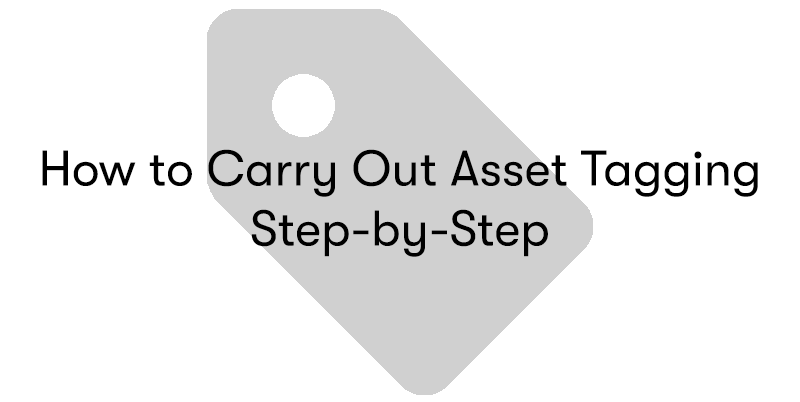
Asset tagging is a structured process that involves several key steps to ensure it's done effectively and efficiently. Here's a step-by-step guide to carrying out asset tagging:
Step 1. Define Your Objectives
Understand the Purpose: Determine why you tag assets (e.g., for inventory management, loss prevention, maintenance scheduling).
Identify the Assets: Decide which assets need to be tagged. This could include IT equipment, machinery, vehicles, or furniture.
Step 2. Select Appropriate Asset Tags
Choose Tag Material: Depending on the environment and usage, select durable materials (metal, plastic, tamper-evident labels).
Determine Tag Type: Decide between barcodes, QR codes, RFID tags, etc., based on your tracking needs.
Step 3. Establish a Tagging System
Develop a Coding System: Create a unique identification system (like serial numbers or barcodes) for each asset.
Asset Information: Decide what information to include on the tags (asset name, purchase date, etc.).
Step 4. Procure and Prepare Tags
Order Tags: Purchase tags from a reliable supplier.
Prepare Tags: Print or encode tags with necessary information.
Step 5. Implement an Asset Management Software
Choose Software: Select an asset management software system compatible with your tagging system.
Integrate Data: Ensure the software can read and store the information from the tags.
Step 6. Tagging Process
Clean Assets: Ensure the surface where the tag will be applied is clean.
Apply Tags: Affix the tags to the assets in a consistent and easily accessible location.
Document: Record the tagging process, noting which assets are tagged with their respective tag numbers.
Step 7. Train Staff
Training: Educate your staff on how to use the tagging system and software.
Usage Policies: Establish guidelines for handling and reporting tagged assets.
Step 8. Integrate into Operations
Regular Scanning: Incorporate regular scanning of assets into operational procedures.
Maintenance and Audits: Use the data from tags for scheduling maintenance and conducting audits.
Step 9. Ongoing Management
Update Records: Regularly update asset records in your management system, especially after acquisitions or disposals.
Re-tagging: Replace damaged or lost tags as needed.
Step 10. Review and Adjust
Monitor Effectiveness: Regularly assess the effectiveness of the asset tagging system.
Make Improvements: Make adjustments to the system based on feedback and changing needs.
Implementing an asset tagging system requires careful planning and execution. It's essential to ensure that the system you set up is scalable, flexible, and meets your organisation's specific needs. Regular reviews and updates to the system will help maintain its effectiveness over time.
What Are the Different Types of Asset Tags?
Asset tags come in various forms, each suited to different applications and environments. Here are the primary types of asset tags:
| Type of Tag | Description | Use Cases | Advantages |
| Barcode Tags | These tags use a series of black-and-white bars to represent data. | Ideal for general asset tracking, inventory management, and check-in/check-out processes. | Easy to use and cost-effective; compatible with a wide range of scanning devices. |
| QR Code Tags | QR (Quick Response) codes can store more data than traditional barcodes. | Useful for detailed asset information, linking to online resources, or when quick scanning is necessary. | It can be scanned with smartphones and can store URLs, text, or numbers. |
| RFID Tags | Radio-frequency identification tags use electromagnetic fields to identify and track tags attached to objects automatically. | Ideal for tracking high-value items, real-time location tracking, and environments where line-of-sight scanning is not feasible. | Quick scanning of multiple items simultaneously does not require a direct line of sight. |
| NFC Tags | Near Field Communication tags are a type of RFID that operate at close range. | Useful for access control, asset tracking in confined areas, and interactive marketing. | Can be scanned with NFC-enabled smartphones, facilitating easy and secure data transfer. |
| Metal Asset Tags | They are made from durable materials like aluminium or stainless steel. | Best for assets used in harsh conditions, outdoor environments, or where high durability is needed. | Resistant to extreme temperatures, chemicals, and abrasion. |
| Tamper-Evident Tags | These tags leave a 'VOID' pattern or other indicator if removed or tampered with. | Ideal for security-sensitive items to prevent unauthorised asset transfer or manipulation. | Deter theft and tampering; provide evidence of tampering. |
| Polyester and Vinyl Tags | Made from durable synthetic materials, often with adhesive backing. | Suitable for general office equipment, IT assets, and indoor use. | Resistant to water, mild chemicals, and moderate temperatures. |
| Magnetic Tags | These are flexible, magnet-based tags. | Useful for temporary tagging or assets that require frequent re-tagging. | Easy to apply and remove; can be repositioned without residue. |
Each type of asset tag has its unique set of features and benefits. The choice of which type to use depends on factors like the nature of the asset, the environment it's used in, the required durability, and the level of security or tracking detail needed. Proper selection of asset tags is crucial for effective asset management and tracking.
What Types of Assets Should be Tagged?
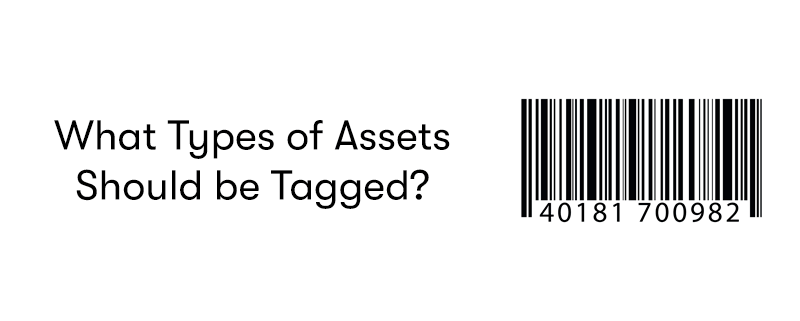
Determining which assets to tag is an essential aspect of asset management. Generally, the decision to tag assets is based on their value (both monetary and operational), the need for tracking, and the risk of loss or theft. Here are some common types of assets that businesses often choose to tag:
IT Equipment
- Computers, laptops, tablets, and servers.
- Networking devices like routers, switches, and modems.
- Peripheral devices like printers, scanners, and projectors.
Office Furniture and Equipment
- Desks, chairs, and filing cabinets.
- Office appliances like copiers and coffee machines.
Machinery and Tools
- Heavy machinery used in manufacturing or construction.
- Power tools and hand tools.
- Specialised equipment for specific industries (e.g., medical devices, laboratory equipment).
Electronic Devices
- Audio-visual equipment like cameras, microphones, and speakers.
- Telecommunication devices such as phones and communication radios.
Vehicles and Transport Equipment
- Company cars, trucks, and vans.
- Specialised vehicles like forklifts and golf carts.
- Bicycles and other personal transport devices are used for business purposes.
Software and Digital Assets
- Licenses for software applications and operating systems.
- Digital media assets like images, videos, and documents.
Fixed Assets and Real Estate
- Buildings and land.
- Permanent fixtures and installations.
High-Value or Sensitive Items
- Artwork and collectables.
- Confidential documents and files.
- Safety and security equipment.
Inventory
- Retail products for sale.
- Raw materials and components for manufacturing.
Leased and Loaned Assets
- Equipment or vehicles that are leased from another company.
- Items loaned to employees or other companies.
The decision to tag certain assets depends on factors like the asset's cost, its criticality to business operations, the likelihood of theft or loss, and the need for regular maintenance or updates. By tagging these assets, businesses can effectively monitor and manage their usage, maintenance, and lifecycle, ultimately improving operational efficiency and asset accountability.
How Does Asset Tagging Relate to ITAM?
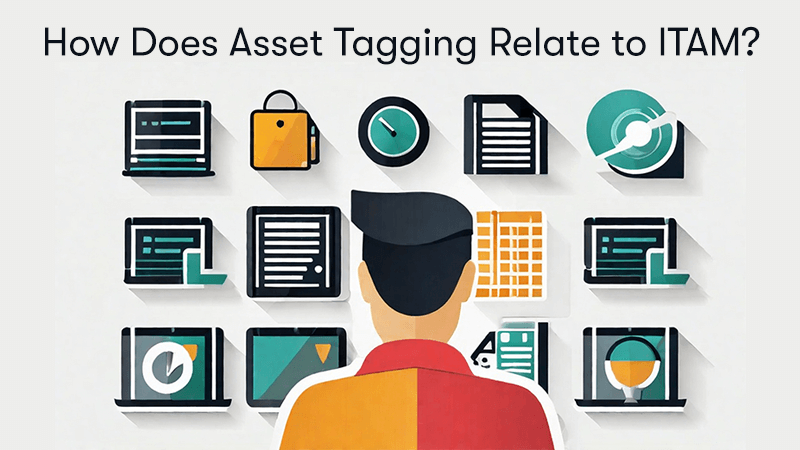
Asset tagging is a fundamental component of IT Asset Management (ITAM), which ensures an organisation's IT assets are accounted for, deployed, maintained, upgraded, and disposed of when the time comes. Here's how asset tagging relates to and supports ITAM:
Identification of IT Assets
Each IT asset is tagged with a unique identifier, which is crucial for tracking and managing these assets throughout their lifecycle. ITAM requires precise identification of assets to manage them effectively.
Inventory Management
Tags help maintain an accurate and up-to-date inventory of IT assets. A well-maintained inventory is essential for effective ITAM, aiding in resource allocation, planning upgrades, and ensuring license compliance.
Tracking and Monitoring
Asset tags enable tracking locations and status of IT assets, including movement between locations or departments. ITAM involves monitoring the use and performance of IT assets, which is facilitated by accurate tracking.
Maintenance and Updates
Tags can store or link to information about maintenance schedules, warranty periods, and update histories. Regular maintenance and timely updates are integral to ITAM for optimising the performance and extending the life of IT assets.
Compliance and Auditing
Asset tags help ensure all IT assets are accounted for and compliant with licensing and regulatory requirements. ITAM requires regular audits and compliance checks to manage software licenses, avoid legal issues, and adhere to industry standards.
Cost Management
Helps track and analyse the cost associated with each IT asset over its lifecycle. Effective cost management is a key goal of ITAM, ensuring that IT expenditures are justified and optimised.
Asset Disposal and Decommissioning
Tags inform when an asset should be retired and aid in the secure decommissioning process. Proper disposal of IT assets, in compliance with data security and environmental regulations, is an important aspect of ITAM.
Risk Management
By knowing the exact details and status of IT assets, organisations can better assess and manage risks associated with these assets. Managing risks, including those related to security breaches or system failures, is a crucial component of ITAM.
Support and Service Management
Tags facilitate quicker support and service management by quickly identifying the assets and their technical details. Efficient support and service management are part of maintaining the health and functionality of IT assets.
Asset tagging is not just a process of labelling IT assets but a critical enabler of effective ITAM. It provides the foundational data and tracking capability required for managing the IT asset lifecycle, ensuring that assets are efficiently utilised, adequately maintained, and aligned with the organisation's overall IT strategy.
Final Notes on Asset Tagging
In conclusion, our exploration into asset tagging has illuminated its critical role in modern business operations. Asset tags, which include barcodes, QR codes, RFID, and NFC tags, offer immense benefits in tracking and managing physical and digital assets. From enhancing inventory management to ensuring efficient asset utilisation and compliance, these tags are indispensable tools in asset management. Particularly in the context of IT Asset Management, asset tagging proves to be a cornerstone for maintaining the lifecycle of IT assets.
As we've discussed, the strategic implementation of asset tagging systems streamlines organisational processes. It fortifies risk management and cost efficiency, making it an essential practice for businesses aiming to optimise their asset-related operations and decision-making.


